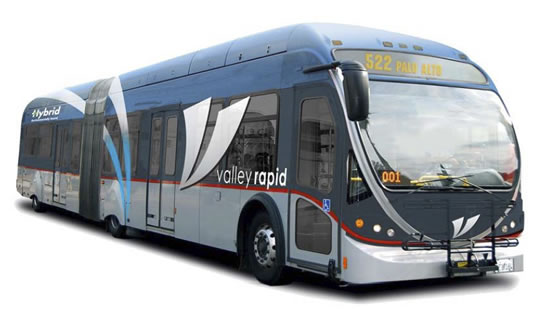Val Carpenter has been known to say that watching government in action is like watching sausage making, more than you want to know. But at the Jan. 24 Tuesday night meeting of council of elected officials you can see in these 1 minute clips that the council did a fine job of “cross-examining” the VTA Bus Rapid Transit representative. (Requires Microsoft Silverlight plugin for a PC or Mac. One-click install.)
This VTA Bus Rapid Transit agenda item was a proposal from the (Santa Clara) Valley Transportation Authority (VTA). It was for a bus rapid transit (BRT) corridor along El Camino Real.Kevin Connelly presented the VTA’s preliminary BRT plans.
Bus Rapid Transit (BRT) is souped up express bus service with “dedicated bus lanes” or “mixed flow lanes” and new sheltered train-like bus stops
From the VTA website:
“BRT includes exclusive bus lanes, high-capacity hybrid vehicles, more frequent service, traffic signal priority, rail-like stations, WiFi, real-time passenger information, level boarding and off-vehicle fare collection. Once implemented BRT has the potential to increase ridership, reduce travel times, ease congestion and attract people out of their cars.”
El Camino Real is 120 feet wide, three lanes in each direction. During rush hour, traffic is a mess. VTA presented two alternatives. The first was “mixed mode” in which buses use the same lanes as cars. Bus travel time would be reduced by adding curb bulb-outs at bus stops so the buses don’t have to pull into a cutout. The second was a “4+2” configuration, removing one lane in each direction which would be devoted exclusively to buses. The current plan is to have the dedicated bus lanes extend from Scott Blvd. in Santa Clara to Showers Dr. in Los Altos. VTA stated that constructing either plan would lead to increased auto congestion on El Camino Real, but that drivers would find alternative routes.
The current plan is to have the dedicated bus lanes extend from Scott Blvd. in Santa Clara to Showers Dr. in Los Altos. Palo Alto is not involved.
To add to the confusion, VTA Bus Rapid Transit has divided the sales function into two geographic areas: the “northern cities” (Palo Alto, Los Altos, Mountain View) and the other impacted cities (Sunnyvale, Santa Clara, and San Jose). To see the presentations for each of the northern cities, click the link on the city name above.
There was a public comment about the proposed VTA Bus Rapid Transit from an avid commuting biker. Gary Heaton said said he never rides a bike on El Camino. He implied that even with a bike lane the route could remain unpleasant compared to alternative side street routes. However, if the plan were to proceed, do build an option with bike lanes.
It emerged during discussion that Mountain View would only consider a “mixed flow lanes” option, but even for that option Mountain View council members sentiment in a straw-vote was 4 no, 2 yes, with 1 abstaining.
Below you can see each council member uncovering serious issues for Los Altos with the VTA preliminary plan…in 1 minute clips.
Ron Packard Asks about the Ridership Forecast of the Plan –
Trust the Federal Government to do traffic! Not!
Council member Ron Packard admitted to not feeling polite. He said the $240 million VTA Bus Rapid Transit would be a waste. He’d like the project planning to just stop. What was the bus ridership model? He’d seen VTA rider projections miss by a wide margin before. “I have no confidence in the federal government when it comes to traffic.”
Jarett Fishpaw Uncovers the Plan’s Negative Impact on right turn access to Whole Foods
Many cars (illegally) use the existing bus stop lane at Showers in front of Whole Foods as a right-hand turn lane into Whole Foods. Putting a VTA Bus Rapid Transit large sheltered bus stop there instead of a bus stop lane would disrupt flow, and cars might back up for quite a distance.
David Casas Uncovers Negative Impact on left turn access to Whole Foods
David Casas observed that the proposed plan will negatively impact the Showers El Camino intersection, where the articulated bus stop is planned, and hamper circulation for Whole Foods. The impact could extend all the way to San Antonio.
Megan Saterlee Explores Loss of Capacity and Traffic Diversion to Residential
Megan Saterlee was concerned about where the 950 cars an hour displaced by bus lanes would go? These people could not be accommodated by the extra buses of the VTA Bus Rapid Transit even if they should want to go by the bus. Those displaced cars that might take Central Expressway would be going out of their way, increasing total miles traveled. Some might head for Foothill Expressway increasing the traffic on collector roads like El Monte and Grant Road. The city already gets complaints.
Val Carpenter affirms that Whole Foods is a large taxpayer to Los Altos
Val Carpenter and Jarret Fishpaw observed that Whole Foods and The Vitamin Shop are among the 25 top sales tax revenue generators for Los Altos. It was asked if the prospective Garden Supply site development project had been considered by VTA? The answer, “Not yet. Plans are fluid.”
WHAT’S NEXT: The Los Altos City Council needs to comment in writing by April 1 to the VTA. If in April most of the cities along the route approve only the “mixed flow” option or opt for “no build,” the VTA Bus Rapid Transit plan may not qualify for the federal money…and the planning would likely stop.
EDITORIAL COMMENT:
On the face of it, removing two traffic lanes from 17 miles of El Camino Real seems insane. Why propose such an apparently dumb idea? The answer (you could have guessed this) is that Federal government “carrot” money is involved. Our federal government requires that at least half the distance of any BRT project must be dedicated bus lanes to get the carrot. Great. Probably the VTA will be spending a ton of money on consultants, architects, and so on, only to learn that the affected cities want no part of this plan.
So Los Altos Policito agrees with Ron Packard, “Please stop wasting taxpayer money” (up to $240 million) with this planning.
The cities in the three counties along the Peninsula have only recently got it together to coordinate traffic light timing on El Camino. It actually is possible to drive 10 miles in 15 minutes at many times of day. It would be a real shame to lose El Camino as a major car carrying corridor. Longer term Los Altos Politico’s prefered approach to Bay Area traffic congestion is the hi-tech sci-fi approach: wait for more telecommuniting to take hold, and also wait for more Google type smart cars that drive themselves and can be packed together with 2 feet following distances!
Telecommuting…Google self-driving cars…Smart cars on Smart lanes.










[…] Editor: City Council heard the VTA present it’s plan for the Los Altos portion of El Camino last January and criticized it. Read the post, see more fotos here. […]